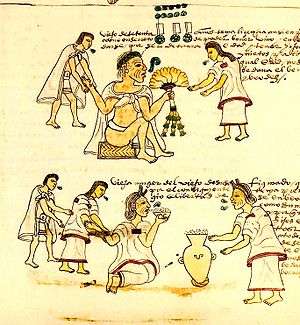Loincloth

A loincloth is a one-piece garment, sometimes kept in place by a belt. It covers the genitals and, at least partially, the buttocks.
History and types
Loincloths are being and have been worn in societies where no other clothing is needed or wanted, as an undergarment or swimsuit, by wrestlers and by farmers in paddy fields in both Sri Lanka and India, where it is called kaupinam or Kov(m)anam or langot.
The loincloth, or breechcloth, is a basic form of dress, often worn as the only garment. Men have worn a loincloth as a fundamental piece of clothing which covers their genitals, not the buttocks, in most societies which disapproved of genital nakedness throughout human history. The loincloth is in essence a piece of material, bark-bast, leather, or cloth, passed between the legs and covering the genitals. Despite its functional simplicity, the loincloth comes in many different forms.

A breechcloth, or breechclout, consists of a strip of material (bark, cloth, leather) passed between the thighs and secured by a belt. A loincloth is a long piece of cloth, passed between the thighs and wound around the waist.
Breechcloths and loincloths are garments of dignity among those who traditionally wear them. The styles in which breechcloths and loincloths can be arranged are myriad. Both the Bornean sirat and the Indian dhoti have fabric pass between the legs to support a man's genitals.
A similar style of loincloth was also characteristic of ancient Meso-America. The male inhabitants of the area of modern Mexico wore a wound loincloth of woven fabric. One end of the loincloth was held up, the remainder passed between the thighs, wound about the waist, and secured in back by tucking.[1]

In Pre-Columbian South America, ancient Inca men wore a strip of cloth between their legs held up by strings or tape as a belt. The cloth was secured to the tapes at the back and the front portion hung in front as an apron, always well ornamented. The same garment, mostly in plain cotton but whose aprons are now, like T-shirts, sometimes decorated with logos, is known in Japan as etchu fundoshi.
Some of the culturally diverse Amazonian Indians still wear an ancestral type of loincloth.
Japanese men wore until recently a loincloth known as a fundoshi. The fundoshi is a 35 cm (14 in.) wide piece of fabric (cotton or silk) passed between the thighs and secured to cover the genitals.
Breechcloth

A breechcloth, or breechclout, is a form of loincloth consisting in a strip of material – usually a narrow rectangle – passed between the thighs and held up in front and behind by a belt or string.[2][3] Often, the flaps hang down in front and back.[3]
Native Americans
In most Native American tribes, men used to wear some form of breechcloth, often with leggings.[3][4][5][6] The style differed from tribe to tribe. In many tribes, the flaps hung down in front and back; in others, the breechcloth looped outside the belt and was tucked into the inside, for a more fitted look.[3] Sometimes, the breechcloth was much shorter and a decorated apron panel was attached in front and behind.[3]
A Native American woman or teenage girl might also wear a fitted breechcloth underneath her skirt, but not as outerwear. However, in many tribes young girls did wear breechcloths like the boys until they became old enough for skirts and dresses.[3] Among the Mohave people of the American Southwest, a breechcloth given to a young female symbolically recognizes her status as hwame.[7]
Japanese and Europeans
Some European men around 2000 BC wore leather breechcloths, as can be seen from the clothing of Ötzi.[8]
Japanese men traditionally wore a breechcloth known as a fundoshi. The fundoshi is a 35 cm (14 in.) wide piece of fabric (cotton or silk) passed between the thighs and secured to cover the genitals. There are many ways of tying the fundoshi.[9]
See also
References
- ↑ Local names: Nahuatl maxtlatl, Mayan ex.
- ↑ U.S. National Park Service. Retrieved on 2009-12-22.
- 1 2 3 4 5 6 Native Languages. Retrieved on 2009-12-22.
- ↑ Minor, Marz & Minor, Nono (1977). The American Indian Craft Book. Bison Books. pp. 72-73. ISBN 0-8032-5891-7. Google Book Search. Retrieved on 2010-07-15.
- ↑ Mayfield, Thomas Jefferson (1997). Adopted by Indians: A True Story. Heyday Books. p. 83. ISBN 0-930588-93-2. Google Book Search. Retrieved on 2010-07-15.
- ↑ Typical Indian Clothing (male). Retrieved on 2010-07-15.
- ↑ Conner, Sparks, and Sparks, eds. (1997) Cassell's Encyclopedia of Queer Myth, Symbol, and Spirit: Covering Gay, Lesbian, Bisexual, and Transgender Lore
- ↑ South Tyrol Museum of Archaeology. Retrieved 2010-07-15.
- ↑ Fundoshi
External links
| Wikimedia Commons has media related to Loincloths. |
- The Loincloth of Borneo
- Breechcloth on Wordnik, retrieved on 22.12.2009
- Breechcloth by Rick Obermeyer (Dec. 1990), retrieved on 22.12.2009